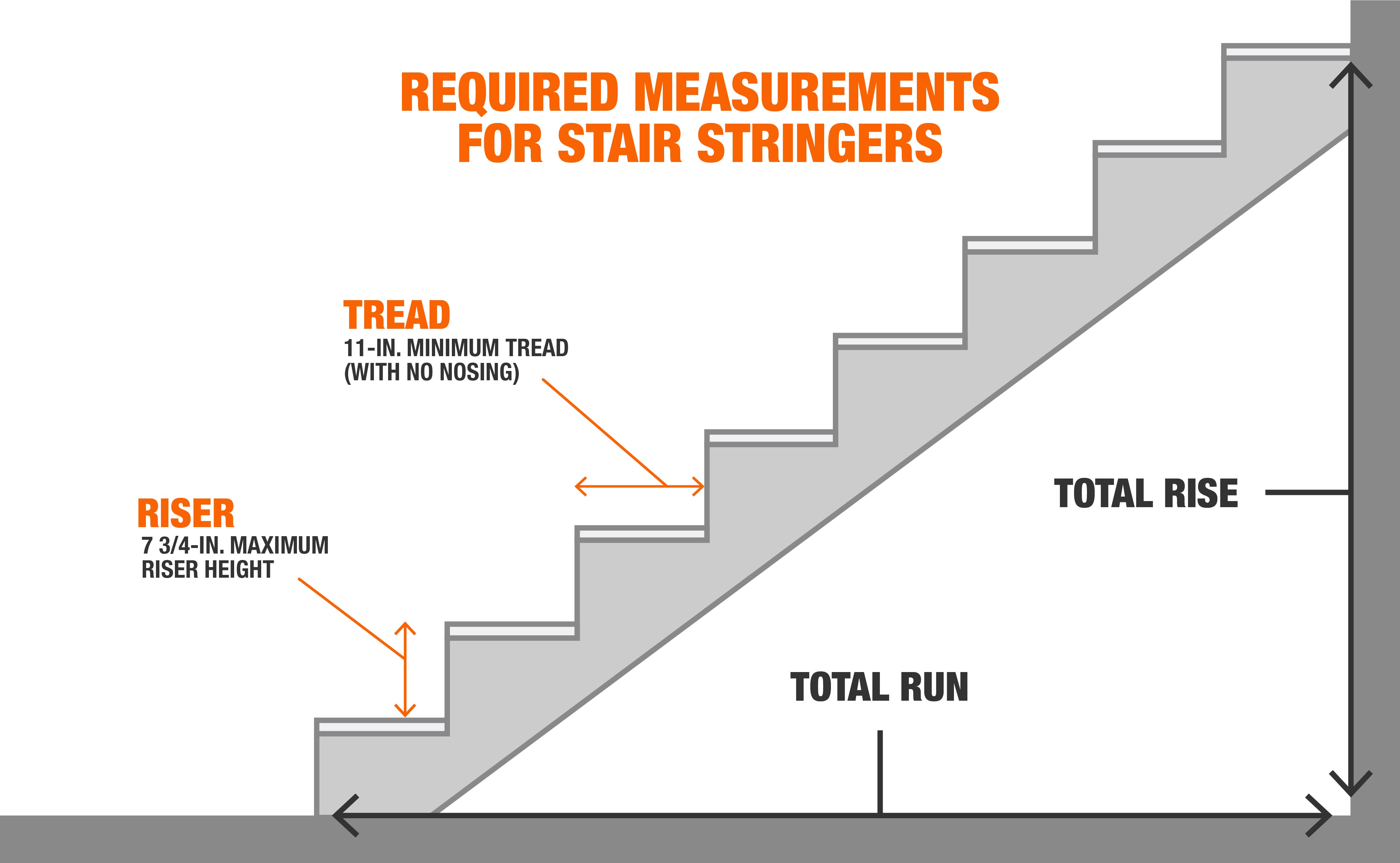How to Measure Stair Stringers

Last updated August 12, 2024
Making stairs correctly means more than complying with building codes. It’s about ensuring your clients’ safety. This guide reviews how to measure stair stringers, as well as how to cut stair stringers and the relevant building requirements.
Measure the stairway’s total rise and divide by the estimated riser height (around 7 inches) for the number of steps. Divide the total rise by the steps for the exact riser height. Use a framing square and pencil to mark all steps on a 2- x 12-inch board.
Difficulty:
Intermediate
Duration:
Under 2 hours
Table of Contents
IRC Requirements & How to Build Stairs
How to Measure Stair Stringers
How to Cut Stair Stringers
Tips for Making Stair Stringers
More Tools. More Products. More Perks.
IRC Requirements & How to Build Stairs

Stair stringers are the notched, diagonal support boards of dimensional lumber that run along the sides and at the center of a staircase. Making stair stringers begins with correct measurements.
The International Residential Code (IRC) and other building codes set requirements for how to build stairs. Most states follow the IRC, but municipalities can make local adjustments. Learn the required measurements for stair risers and treads in your area before calculating stair stringers.
- Stair risers are the vertical section of an individual stair. They have a maximum height of 7 3/4 inches. The IRC does not set a minimum height, but other codes, such as the International Building Code, set a minimum riser height of 4 inches.
- The height of the stairs must be consistent, and the risers cannot vary more than 3/8 inch on a staircase.
- The nosing, or horizontal overhang of a stair, is required to be a minimum of 3/4 inch and a maximum of 1 1/4 inch. Nosings are not required but make stairs safer.
- The tread depth of stairs with nosing must be a minimum of 10 inches. If the stairs do not have a nosing or overhang, the tread has a requirement of 11 inches minimum.
Residential stairs are required to have a minimum width of no less than 36 inches and should have stringers every 16-18 inches. Stairways of 36 inches will need at least three stringers.
Stairways wider than 36 inches will need at least four stringers.
How to Measure Stair Stringers

Knowing how to measure stair stringers requires some simple math. Use the following stair stringer calculator.
- Determine the total rise of the staircase. Use a tape measure to record the distance from the upper floor to the lower floor. If the flooring is not yet installed, add the thickness of the flooring to the total rise.
- Divide the total rise by the estimated height of the stair risers (7- 7 3/4 inches) to determine the approximate number of stairs. If you get an uneven number, round up to the nearest whole number to ensure that the stair risers will not be too high. (See the example below.)
- Divide the total rise by the number of stairs to determine the exact height of the stair risers.
Suppose you’re building stairs that have a total rise of 50 3/4 (50.75) inches:
- Divide 50 3/4 by an estimated height of 7 3/4 (7.75). This leaves a total of 6.55.
- Round 6.55 up to 7 for the total number of stairs.
- Divide 50 3/4 by 7 stairs. This leaves a total riser height of 7 1/4 inches. (If you rounded 6.55 down to 6, for 6 total stairs, the rise would be more than 8 inches and would not be code compliant.)
Determine the total run of the staircase by multiplying the number of stairs by the tread. For example, 7 steps with 11 inches of tread each means a total run of 77 inches.
Pro tip: When estimating the minimum board size you need, assume 14 inches of board length per step. For example, a stringer with 7 steps will need a board of 84 inches (7 x 14 = 84).
How to Cut Stair Stringers

Follow this method for how to mark stair stringer dimensions.
- Use 2- x 12-inch boards of the straightest possible lumber with the fewest knots. Boards smaller than 2- x 12-inches will not leave enough wood to carry the load of the stair after the stringers are cut. Begin with boards that are about 12 inches longer than the total length of the stringer.
- Use a framing square to mark the lengths of the rise and the run. Consider using an erasable marker or multi-colored tape to indicate the measurements on the arms of the square.
- Beginning a few inches from the end of the board, use a pencil to mark the lengths of the tread and riser for the top stair notch.
- Mark the remaining stringer notches, starting at the same point where the previous notch ended.
- When you’ve finished marking the steps, extend the final, lowest tread line to the back edge of the board. This creates the straight edge where the stringer meets the floor. Then deduct the thickness of your flooring from the measurement to ensure that the tread is not too tall. For example, if the flooring will be 1 inch thick, deduct 1 inch from the measurement.
Follow these steps for how to cut stair stringers:
- Clamp the marked board onto sawhorses or a cutting surface.
- Wear safety glasses.
- Use a circular saw to cut the notches along the pencil lines, leaving 1/2 inch from the inner corners uncut so you don’t overcut the lines.
- Finish cutting the notches with a hand saw or reciprocating saw for a cleaner, more exact cut.
Tips for Making Stair Stringers

Follow these tips for making stair stringers.
- When measuring the total rise with an unfinished floor, place a sample piece of flooring to make measuring easier and more accurate.
- The sum of one rise and one tread should be 17-18 inches. If the sum is greater than 18 3/4 inches, there’s a mistake. Correct your measurements.
- After calculating the stair stringers' rise and run, make a sketch of the staircase and label the measurements as a visual aid.
- Test the framing square by making pencil marks on the back of the board.
- After cutting the first stringer, use it as a template for marking the subsequent ones so you don’t need to use the framing square each time.
More Tools. More Products. More Perks.

Be more competitive and boost your bottom line with Pro Xtra, The Home Depot's loyalty program built for Pros. Sign up today to access the enhanced Pro Online Experience, built with the online business tools and time-saving features Pros need.
Authorize employee in-store purchases quickly and securely via text. When Pro Xtra members enroll in Text2Confirm, you have total visibility to a detailed list of everything your employee is buying.



























